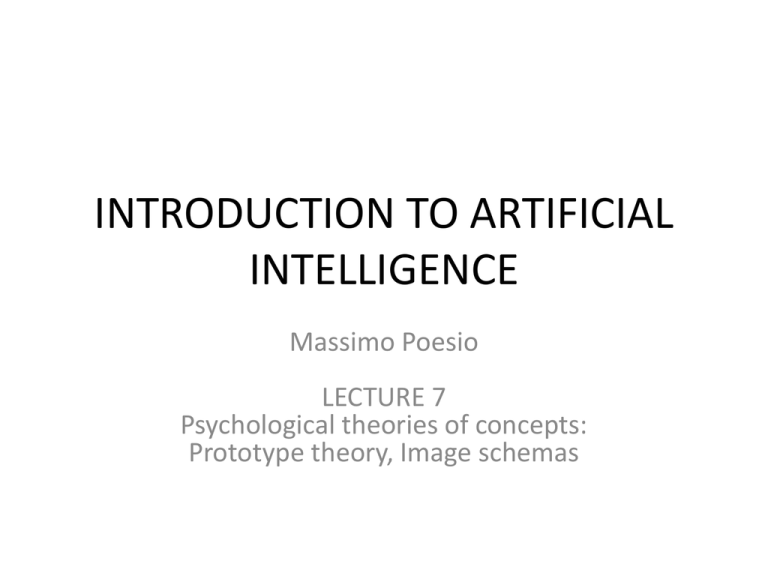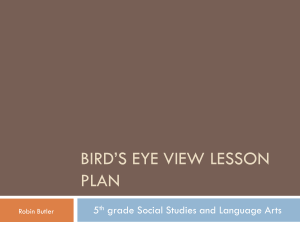
INTRODUCTION TO ARTIFICIAL
INTELLIGENCE
Massimo Poesio
LECTURE 7
Psychological theories of concepts:
Prototype theory, Image schemas
Evidence for the taxonomic theory
of concepts
• Collins & Quillian, 1969, 1970
– Evidence: When people do a semantic verification task, you see
evidence of a hierarchy (response times are correlated with the
number of links).
Superset
(category):
Property:
Number of links:
A canary is a canary
(S0)
A canary can sing
(P0)
0
A canary is a bird
(S1)
A canary can fly
(P1)
1
A canary is an
animal (S2)
A canary has skin
(P2)
2
Semantic networks
• Collins & Quillian, 1970:
Collins & Quillian (1970, p. 306; reporting data from Collins & Quillian, 1969)
Semantic network models (Collins
& Quillian, 1970)
• Concepts are organized as a set of nodes and
links between those nodes.
– Nodes hold concepts. For example, you would
have a node for RED, FIRE, FIRETRUCK, etc. Each
concept you know would have a node.
– Links connect the nodes and encode relationships
between them. Two kinds:
• Superset/subset: Essentially categorize. For example, ROBIN
is a subset of BIRD.
• Property: Labeled links that explain the relationship between
various properties and nodes. For example, WINGS and BIRD
would be connected with a “has” link.
Semantic network models
Collins & Quillian (1970, p. 305)
Semantic network models
• The nodes are arranged in a hierarchy and distance (number
of links traveled) matters. The farther apart two things are,
the less related they are. This is going to be important in
predicting performance.
• The model has a property called cognitive economy. Concepts
are only stored once at the highest level to which they apply
(e.g., BREATHES is stored at the ANIMAL node instead of with
each individual animal). This was based on the model’s
implementation on early computers and may not have a brain
basis. Also, not necessarily crucial for the model.
PROBLEMS FOR THE CLASSICAL
THEORY OF CONCEPTS
• The view dominant since Aristotle that
knowledge is organized around concepts
whose definitions provide necessary and
sufficient conditions in terms of genus and
differentia (ie in terms of a taxonomic
organization) has been challenged first from
within Philosophy, then from within
Psychology
PLATO’S PROBLEM
For many concepts, there simply aren’t
any definitions” (LM p.14)
A theory that correctly describes the behavior
of perhaps three hundred words has been
asserted to correctly describe the behavior of
the tens of thousands of general names
(Putnam)
WITTGENSTEIN’s EXAMPLE:
‘GAME’
• What is common to all games?
– Are they all ‘amusing’?
• Cfr. chess
– Or is there always winning and losing?
• Counterex: child throwing his ball at the wall
– Look at the parts played by skill and luck
• “I can think of no better expression that FAMILY
RESEMBLANCE”
– ‘games form a family’
PROBLEMATIC EVIDENCE FROM
PSYCHOLOGY
• Typicality effects
– Is a tomato a vegetable or a fruit?
– ‘Is this art?’
• Evidence that IS-A may have different
properties – eg., failures of transitivity
– If A is a B and B is a C, is A a C?
• Evidence that categorization may not be based
on necessary and sufficient conditions
• Basic level effects
Typicality effects
• Rips, Shoben & Smith (1973): Typicality seems
to influence responses.
– Technically, “a robin is a bird” and “a chicken is a
bird” are each one link. But, the robin is more
typical. What is that in the network? Shows up in
reaction times as well.
Typicality ratings
Smith, Shoben, & Rips (1974, p. 218)
Typicality effects
• With the hierarchy: “A horse is an animal” is
faster than “A horse is a mammal” which
violates the hierarchy.
• A chicken is more typical of animal than a
robin, a robin is more typical of bird than a
chicken. How can a network account for this
(Smith, Shoben, & Rips, 1974)?
Typicality effects
• Answering “no”: You know the answer to a
questions is “no” (e.g., “a bird has four legs”)
because the concepts are far apart in the
network. But, some “no” responses are really
fast (e.g., “a bird is a fish”) and some are
really slow (e.g., “a whale is a fish”). The
reason for this isn’t obvious in the model.
• “Loosely speaking, a bat is a bird” is true, but
how does a network model do it (Smith,
Shoben, & Rips, 1974)?
Agreement on typicality judgments
• Agreement on typicality judgments
– (‘think of a fish, any fish’)
– Rosch (1975): very high correlation (.97) between
subjects’s typicality rankings for 10 categories
TYPICALITY JUDGMENTS
1 chair
1 sofa
3 couch
3 table
5 easy chair
6 dresser
6 rocking chair
8 coffee table
9 rocker
10 love seat
11 chest of
drawers
12 desk
13 bed
...
...
22 bookcase
27 cabinet
29 bench
31 lamp
32 stool
35 piano
41 mirror
42 tv
44 shelf
45 rug
46 pillow
47 wastebasket
49 sewing
machine
50 stove
54 refrigerator
60 telephone
Other typicality effects
• Learning: typical items learned before atypical ones
(Rosch Simpson & Miller 1976)
– Learning is faster if subjects are taught on typical items
• Typicality affects speed of inference
– Rips 1975:
– Garrod & Sanford 1977: faster reading time for “The bird
came in through the front door” when ROBIN than when
GOOSE
Feature models
• Smith, Shoben, & Rips, 1974:
– Concepts are clusters of semantic features. There are two
kinds:
• Distinctive features: Core parts of the concept. They
must be present to be a member of the concept,
they’re the defining features. For example, WINGS for
BIRD.
• Characteristic features: Typically associated with the
concept, but not necessary. For example, CAN FLY for
BIRD.
Feature models
Smith, Shoben, & Rips (1974, p. 216)
Feature models
– Some examples:
BIRD
MAMMAL
Distinctive
Wings
Feathers…
Nurses-young
Warm-blooded
Live-birth…
Characteristic
Flies
Small…
Four-legs…
ROBIN
WHALE
Distinctive
Wings
Feathers…
Swims
Live-birth
Nurses-young…
Characteristic
Red-breast
Large
Feature models
– Why characteristic features? Various evidence, such as
hedges:
Smith, Shoben, & Rips (1974, p. 217)
Feature models
– Why characteristic features? Various evidence, such as
hedges:
• OK:
– A robin is a true bird.
– Technically speaking, a chicken is a bird.
• Feels wrong:
– Technically speaking, a robin is a bird.
– A chicken is a true bird.
• The answer depends on the kinds of feature overlap.
Feature models
– Answering a semantic verification question is a two-step
process.
• Compare on all features. If there is a lot of overlap it’s
an easy “yes.” If there is almost no overlap, it’s an easy
“no.” In the middle, go to step two.
• Compare distinctive features. This involves an extra
stage and should take longer.
Smith, Shoben, & Rips (1974, p. 222)
Feature models
– Some questions:
Easy “yes”
Easy “no”
Hard “yes”
Hard “no”
A robin is a bird
A robin is a fish
A whale is a
mammal
A whale is a fish
Feature models
– Can account for:
• Typicality effects: One step for more typical members, two steps
for less typical members, that explains the time difference.
• Answering “no”: Why are “no” responses different? Depends on
the number of steps (feature overlap).
• Hierarchy: Since it isn’t a hierarchy but similarity, we can
understand why different types of decisions take different
amounts of time.
Feature models
– Problem: How do we get the distinctive features?
• What makes something a game? What makes someone a
bachelor? How about cats?
• How many of the features of a bird can you lose and still have a
bird?
• The distinction between defining and characteristic features
addresses this somewhat, but it is still a problem in
implementation.
FEATURE NORMS
• Psychologists have been collecting concept features
from subjects at least since Rosch and Mervis (1975)
• Different methodologies used (from free association
to very tightly controlled)
• Three such databases currently available
– Garrard et al (2001) - GA
– Vinson and Vigliocco (2004) - VV
– McRae et al (2005) – MCRA - the largest, also classified
SPEAKER-GENERATED FEATURES (VINSON AND
VIGLIOCCO)
FEATURE NORMS (GARRARD)
What makes an item typical? Rosch &
Mervis 1975
•
Items are typical when they have HIGH FAMILY RESEMBLANCE with
members of the category:
–
–
–
•
Typical items have many of the attributes of members
Do not have properties of nonmembers
Irrespective of frequency: ORIOLE vs CHICKEN
Evidence 1: checked that subjects agree on typicality for several natural
categories
1.
2.
Asked subjects to list attributes (actually, check)
Weighed each attribute by how many items it occurred with within the
category
1.
3.
‘SCORE’ indicates how many common features
Found that score highly predictive of typicality (.84-.91)
Five most typical ‘furniture’ (CHAIR, SOFA, TABLE, DRESSER, DESK) have 13
features in common
Five least typical (CLOCK, PICTURE, CLOSET, VASE, TELEPHONE) had 2 attributes
in common
Rosch and Mervis 1975 (2)
• Evidence 2: non-typical elements have more
features in common with other categories
• Evidence 3: speed of learning with artificial
stimuli belonging to 2 classes
– Items with more features in common with family
easier to learn
– Items with more features in common with
contrast category harder to learn
‘Fuzzy’ or ‘graded’ categorization
• A necessary and sufficient definition should pick up
all the category members and none of the nonmembers
• But this is not what happens:
– Hampton (1979): no clear division between members and
non-members of 8 categories
• Kitchen utensils: SINK? SPONGE?
• Vegetables: TOMATOES? GOURDS?
CATEGORIES AS CLUSTERS
CHICKEN
GOOSE
ORIOLE
OSTRICH
ROBIN
PROTOTYPE THEORY
• The dominant theory of concepts in
Psychology, developed by E. Rosch and
collaborators in the ’70s
Prototype theory
– Wittgenstein’s examination of game
• Generally necessary that all games be amusing, not
sufficient since many things are amusing
• Board games, ball games, card games, etc. have
different objectives, call on different skills and motor
routines
- categories normally not definable in terms of
necessary and sufficient features
Prototypes and Multidimensional
Concept Spaces
• A Concept is represented by a prototypical item =
central tendency (e.g. location P below)
A new exemplar is classified based on its similarity to the
prototype
Is this a “chair”?
Is this a “dog”?
Is this a “cat”?
Prototype theory in a nutshell
1.
2.
3.
4.
5.
6.
Certain members of a category are prototypical – or
instantiate the prototype
Categories form around prototypes; new members added
on basis of resemblance to prototype
No requirement that a property or set of properties be
shared by all members
Features/attributes generally gradable
Category membership a matter of degree
Categories do not have clear boundaries
Prototype theory
1.
Certain members of a category are prototypical – or
instantiate the prototype
Category members are not all equal
a robin is a prototypical bird, but we may not want to say it is the
prototype, rather it instantiates (manifests) the prototype or ideal -- it
exhibits many of the features that the abstract prototype does
“It is conceivable that the prototype for dog will be unspecified for sex;
yet each exemplar is necessarily either male or female.” (Taylor)
Prototypes and typicality Effects
• typical
– is robin a bird?
– is dog a mammal?
– is diamond a precious stone?
• atypical
– is ostrich a bird?
– is a whale a mammal?
– is turquoise a precious stone?
slower verification times
for atypical items
Prototype theory
3.
No requirement that a property or set of properties be
shared by all members -- no criterial attributes
–
–
Category where a set of necessary and sufficient attributes can be
found is the exception rather than the rule
Labov household dishes experiment
•
•
•
Necessary that cups be containers, not sufficient since many things are
containers
Cups can’t be defined by material used, shape, presence of handles or
function
Cups vs. bowls is graded and context dependent
Graded Structure
• Typical items are similar to a prototype
• Typicality effects are naturally predicted
atypical
typical
Problem with Prototype Models
• All information about individual exemplars is
lost
– category size
– variability of the exemplars
– correlations among attributes
(e.g., only small birds sing)
Exemplar Models
• category representation consists of storage
of a number of category members
• New exemplars are compared to known
exemplars – most similar item will influence
classification the most
dog
??
dog
cat
dog
cat
dog
cat
Exemplar Models
• Model can explain
– Prototype classification effects
• Prototype is similar to most exemplars from a category
– Graded typicality
• How many exemplars is new item similar to?
– Effects of variability
• Overall, compared to prototype models,
exemplar models better explain data from
categorization experiments (Storms et al., 2000)
THE BASIC LEVEL HYPOTHESIS
• Recent psychological evidence also challenges
the taxonomic view developed in work on
ontologies in another respect:
– Not all levels the same
Superordinate level
Superordinate
Preferred level
BASICBasic
LEVEL
Subordinate level
Subordinate
NOT ALL LEVELS ARE THE SAME
• Brown (1958): parents would call a sheepdog
DOG or DOGGIE rather than ANIMAL or
SHEEPDOG
• Rosch et al (1976):
– Subjects name more attributes for basic concepts
(PANTS) than for superordinate (CLOTHING) or
subordinate (JEANS)
– Subjects are faster at verifying that a picture was
a TABLE than it was a PIECE OF FURNITURE of a
KITCHEN TABLE
Basic Level and Expertise
Dog and bird experts identifying dogs and birds at different levels
Experts make subordinate as quickly as basic categorizations
Models of categorization:
Classical vs Prototype / Exemplar
• Classical model
– Category membership determined on basis of
essential features
– Categories have clear boundaries
– Category features are binary
• Prototype model
– Features that frequently co-occur lead to
establishment of category
– Categories are formed through experience with
exemplars
(Image) Schemas
– According to much research in child concept
acquisition, children’s (and adults) conceptual
knowledge is rooted into SCHEMAS
– Regularities in our perceptual, motor and
cognitive systems
– Structure our experiences and interactions with
the world.
– May be grounded in a specific cognitive system,
but are not situation-specific in their application
(can apply to many domains of experience)
Image schemas
• Trajector / Landmark (asymmetric)
TR
– The bike is near the house
– ? The house is near the bike
• Boundary / Bounded Region
LM
boundary
bounded region
– a bounded region has a closed boundary
• Topological Relations
– Separation, Contact, Overlap, Inclusion, Surround
• Orientation
– Vertical (up/down), Horizontal (left/right, front/back)
– Absolute (E, S, W, N)
Boundary Schema
Region A
Region B
Boundary
Roles:
Boundary
Region A
Region B
Bounded Region
Roles:
Boundary: closed
Bounded Region
Background region
Topological Relations
• Separation
Topological Relations
• Separation
• Contact
Container Schema
• Roles:
– Interior: bounded region
– Exterior
– Boundary
C
Source-Path-Goal
Constraints:
initial = TR at Source
central = TR on Path
final = TR at Goal
Source
Path
Goal
SPG -- simple example
She drove from the store to the gas station.
TR = she
Source = the store
Goal = the gas station
Source
Path
Goal
SPG and Container
She ran into the room.
SPG. Source ↔ Container.Exterior
SPG.Path ↔ Container.Portal
SPG. Goal ↔ Container.Interior
Language and Spatial Schemas
• People say that they look up to some people, but look down
on others because those we deem worthy of respect are
somehow “above” us, and those we deem unworthy are
somehow “beneath” us.
• But why does respect run along a vertical axis (or any spatial
axis, for that matter)? Much of our language is rich with such
spatial talk.
• Concrete actions such as a push or a lift clearly imply a vertical
or horizontal motion, but so too can more abstract concepts.
• Metaphors: Arguments can go “back and forth,” and hopes
can get “too high.”
REFERENCES
• E. Rosch & C. B. Mervis, 1975. Family
resemblances. Cognitive Psychology, 7, 573605
• E. Rosch, C. B. Mervis, W. Gray, D. Johnson & P.
Boyes-Braem, 1976. Basic objects in natural
categories. Cognitive Psychology, 8, 382-439










